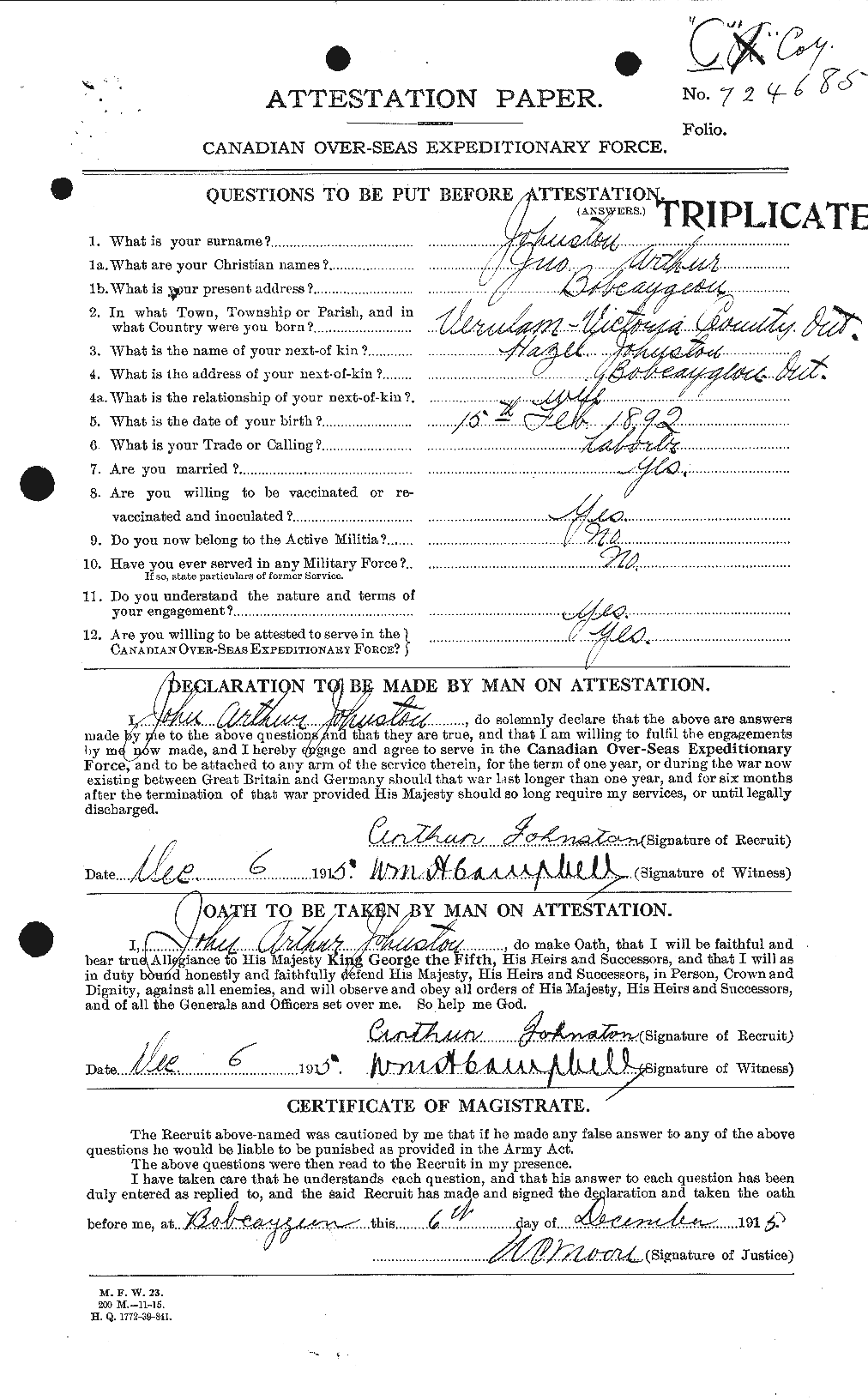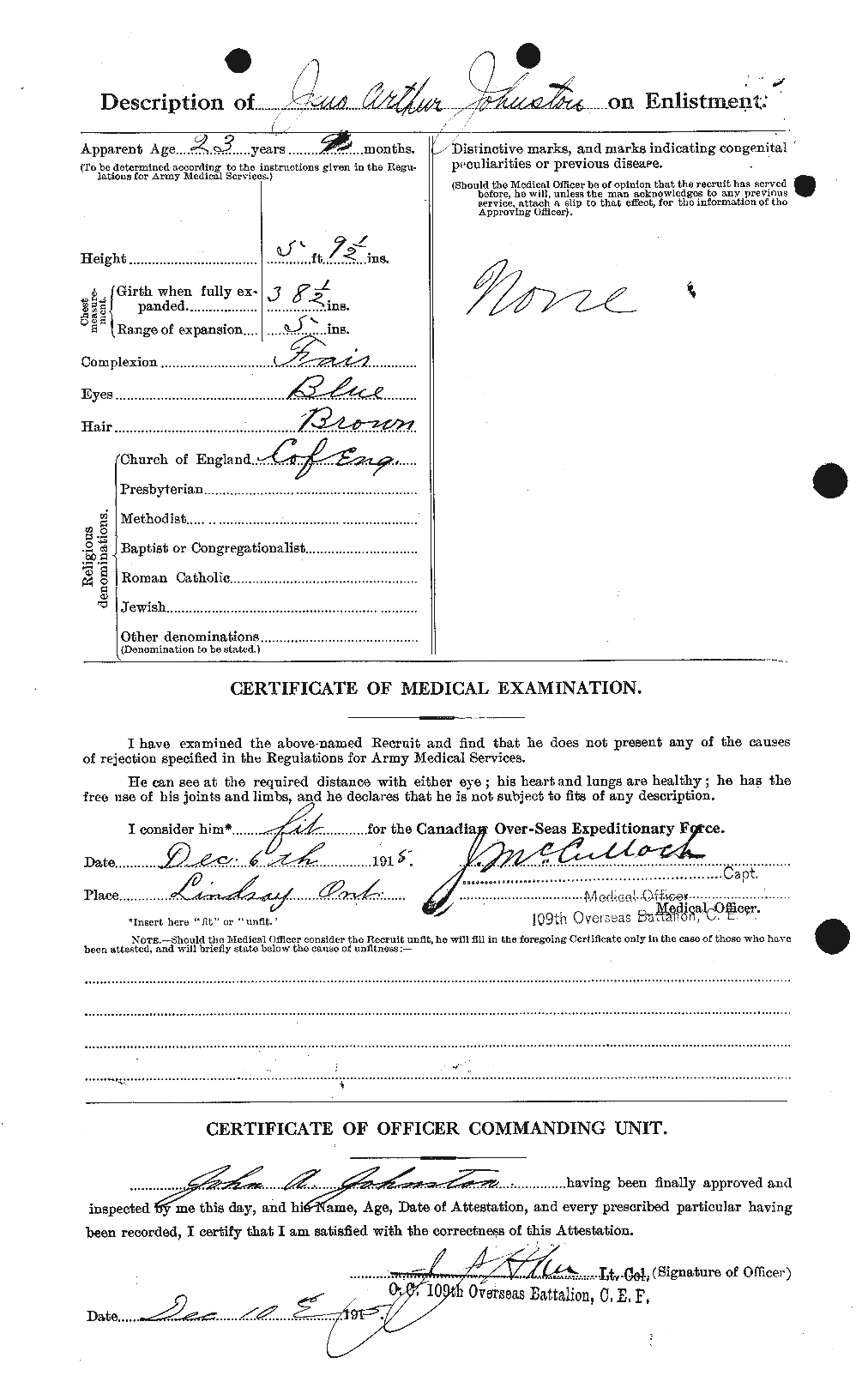

John Arthur Johnston

John Arthur Johnston was born in Verulam-Victoria, Ontario on August, 15, 1917 and lived in Bobcaygeon, Ontario. His religion was the Church of England. John was the son of John Francis and Annie Johnston, and the husband of Katheline Hazel Adams. He enlisted for World War I on December 6, 1915 in Bobcaygeon, Ontario at the age of 23 and his trade was labourer. John had no previous military experience but had agreed to serve for 1 year or during the time of the war between Great Britain and Germany and if the war lasted longer than the year and 6 months King George the Fifth, His Majesty, should still have need for his services. John was a Lance Corporal in The Canadian Infantry 21st Battalion, his regimental number was 724685. He was 5'9.5" and weighed 149 pounds. John had brown hair and blue eyes and his girth when fully expanded was 38.5 inches, the range of expansion was 5 inches. John Arthur Johnston was killed in action on August 15, 1917, when he was 25 years old. Before killed, John had served for 1 year, 8 months and 9 days. Before he passed away he had written his will out to his wife, Katheline Hazel Johnston of Bobcaygeon, Ontario.
Biography
Life in the Trenches
Trenches were long narrow ditches dug into ground, which 140, 000 Chinese served to build. Soldiers lived in the trenches day and night, although they didn't get too much sleep and when they did it was only for about an hour at a time. They would be woken up for different types of things like chores, the types of chores they would have to do were things like filling sandbags and fixing duckboards. The trenches were muddy, had a very delightful smell and were infested with lice and rats that could grow the size of cats. There were also dead bodies that were buried nearby, and toilets would sometimes overflow into the trenches. The trenches often caused soldiers to get diseases like, influenza, typhoid, trench foot, trench fever, malaria, diabetes and frostbite. When it rained the trenches would sometimes be flooded up to the waists of soldiers. Soldiers would usually have 4 days in the frontline, 4 days in the close reserve and 4 days of rest. There would often be sudden deaths of soldiers when they were just resting in the trenches, this was because of the shell bursts from the opposing country. The open space that was between the two opposing trenches was called no man's land because soldiers feared being attacked if going in that area. No man's land sometimes because like a mud bath, soldiers could disappear in it and then never be found again.
History of the 21st Battalion
The 21st Battalion was an infantry battle of the Canadian Expeditionary Force in the Great War. On October 19, 1914 permission was given to create the 21st Battalion. On November 3 1914, the drafts arrived in Kingston which is where the Battalion's headquarters is located. The Battalion was trained throughout the winter until the spring of 1915. Then on May 5, 1915 the 21st Battalion left Kingston by train and headed for Montreal. Once arrived in Montreal they set off on the Troopship Metagama, soon the Battalion had arrived in Devonport, England which is where they continued their training. The 21st Battalion continued to set off and arrive to different places around the world. On September 18 Lieutenant-Colonel Hughes, accompanied by others, left billets at 6:00 AM and continued to the trenches, which the Battalion was going to be taking over. Major CC Bennett ordered the Battalion to start early in the morning on the last lap of travelling to the trenches. The 21st Battalion had served until the ending of the war, receiving many Battle Honours.



Here are fictional letters, written by a highschool student, that would have been written during the time of WWI. To have the letter read to you, click one of the play buttons below.

This page is displayed in the Memorial Chamber of Peace Tower on June 12.

This is a picture of the SS Olympic, which he had boarded on in Halfax, Nova Scotia.



Lance Corporal John Arthur Johnston is also on the War Memorial in Lindsay, Ontario.
Letter #1-
Letter #2-

This is the Vimy Memorial in France, which Lance Corporal Johnston is named on.

Above is an example picture of what trenches looked like.
1892-1917
Lance Corporal
Burial Informaton
John Arthur Johnston was not found after being killed. Although he was named on the Vimy Memorial, along with 11, 285 other Canadians. The Vimy Memorial is in Pas de Calais, France and is Canada's most impressive tribute overseas that was made in honour of the Canadian soldiers that risked their lives for World War I. The memorial was desgined by a Canadian sculptor and architect, Walter Seymour Allward. Vimy Memorial took 11 years to construct and costed over $1.5 million, the memorial was displayed on July 26, 1936 by King Edward VIII.
Above is a map which shows the location of the Vimy Memorial.



